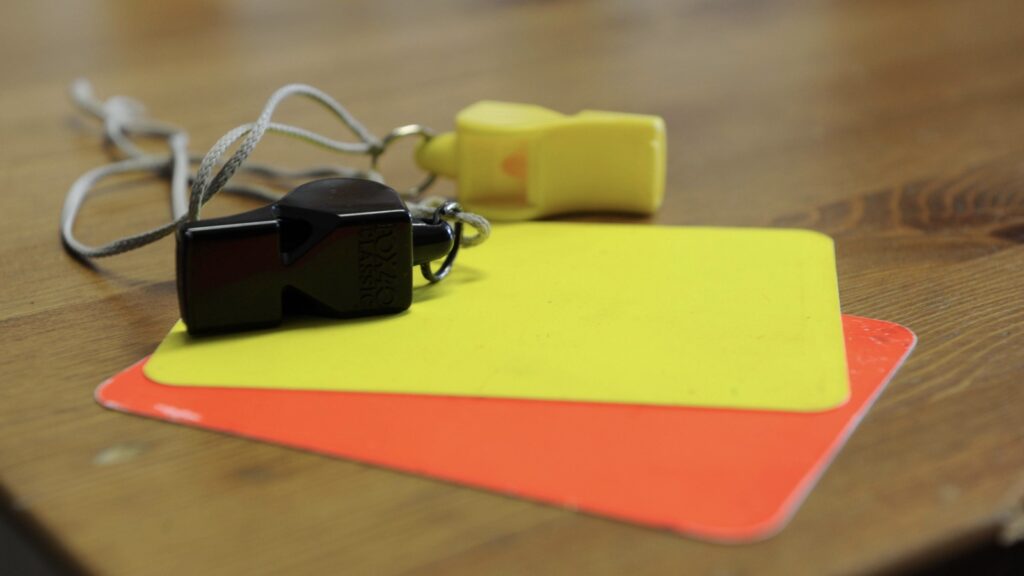In soccer, two little cards can turn the game around — the yellow card and the red card. More than pretty colors, they are significant reminders; they are instruments of authority that referees wield to maintain control of the game. Knowing how they are different can make fans, players, and newcomers appreciate the pace and justice of the sport more.
So, what do these cards signify? Let’s have a look.
What Is a Yellow Card?
A yellow card is a warning given by the referee to a player for unsportsmanlike behavior or rule infractions that are severe, but insufficient to necessitate an ejection. A final warning — a means of saying to the player, “You’ve crossed the line; do it again and you’re out.
Common Offenses That Result in a Yellow Card:
- Reckless tackling
- Dissent (disagreeing with the referee)
- Delays the restart of play
- Fouling repeatedly
- Unsporting conduct (such as pulling your shirt off in celebration)
- Time-wasting
- Entering or exiting the field without being allowed to do so
After a player gets a yellow card, they remain in the game — but they’re treading on very thin ice. Two yellow cards in the same game translate to a red card (more on that below).
What Is a Red Card?
A red card is an instant removal from the game. The player has to exit the field and is not replaceable, leaving their team short of a man for the rest of the game. Red cards are issued for serious fouls, or as a consequence of two yellow cards within a single game.
Fouls That Result in a Direct Red Card:
- Violent behavior (kicking, punching, or headbutting an opposing player)
- Serious foul play
- Spitting at another person
- Denial of a clear scoring chance (by handball or foul)
- Offensive, insulting, or abusive language
- Dangerous tackling that might be injurious
- Yellow Card Accumulation and Suspension
Yellow Card Suspensions
Yellow cards do not necessarily get reset after a single match. In tournaments or leagues, piling up multiple yellow cards over the course of several matches might result in suspensions.
For instance:
- In the FIFA World Cup, two yellow cards in different matches result in a one-match suspension.
- In the majority of local leagues, like the English Premier League, a player will be suspended after five yellow cards in a series of matches (typically by matchday 19).
The system helps ensure the players stay disciplined throughout the season, not only in isolated games.
Red Card Suspensions
The receiving of a red card virtually always results in suspension, the duration of which is determined by the seriousness of the offense.
Two yellow cards in the same game = 1-game ban
Direct red card (persistent foul) = 1-3 game ban
Violent behaviour or insulting language = 3 or more games
In certain instances, players have even been handed longer bans or fines where the incident is referred to a disciplinary panel.
Classic Red Card Moments
Football history is replete with dramatic red card moments. Here are a few that are simply unforgettable:
1. Zinedine Zidane – 2006 World Cup Final
One of the greatest red cards of all time. In his last game, French great Zinedine Zidane was given his marching orders for head-butting Italian defender Marco Materazzi in extra time. France lost the final to Brazil in a penalty shootout.
2. David Beckham – 1998 World Cup Round of 16
England captain David Beckham was ejected for kicking Argentina’s Diego Simeone. England lost the game on penalties. Beckham was heavily criticized in England, but he redeemed himself later.
3. Luis Suárez – 2010 World Cup Quarter-Final
In perhaps the most infamous moment of World Cup history, Suárez intentionally handled the ball on the goal line to prevent Ghana from equalizing. He was given a red card, but Uruguay eventually went on to win the game in a penalty shootout. He was widely hailed as a hero for his “sacrifice.”
4. Pepe – Real Madrid vs. Getafe (2009)
Pepe was red-carded for kicking and punching a player who had been awarded a penalty. He was suspended for 10 games, one of the longest suspensions in history in La Liga.
Why Cards Matter
Yellow and red cards are essential to upholding discipline, safety, and justice in football. Without them, games would quickly descend into anarchy. They allow referees to manage the flow and process of the game and shield players from violent play.
Cards also provide dramatic turning points. One red card can tip a game, fuel controversy, or be an historic moment replayed for decades. For the supporters, they’re a reminder that football isn’t just about talent and goals — it’s about feeling, rules, and the price of going over the edge. Whether you’re sitting through a World Cup final or some Saturday league game, look for those cards — because when they emerge, you know the match is going to turn.
